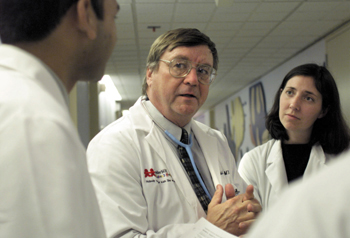
Dr. Arnold Strauss, chair of Pediatrics, believes that particular genes in children trigger heart disease. Strauss is one of the nation's leading authorities in pediatric cardiology research. (photo by Dana Johnson)
Paper out, electronics in
Vanderbilt Medical Group has embarked on a three-year project to replace key paper systems with electronic systems. "Just about every place in the country wants to do this," noted Nancy Lorenzi, professor of Biomedical Informatics and E3 project coordinator. By virtue of Vanderbilt's success with inpatient systems, VMG has a substantial head start over most other practice groups.
The project, known as E3, is on schedule. VMG's Clinical Visioning Design Team first produced a description of how they'd like to see clinical practice change in the context of the information age. The group specifically considered information needs arising before, during and after the patient encounter. Lorenzi combined this description with similar work done in 1997 by the VMG Informatics Committee, and the result was a list of 22 ideas entailing practice changes and new IT solutions. Another VMG group ranked these ideas, resulting in a list of 12 priorities for E3. Work is underway on the top three.
The top priority is an outpatient order entry system that supports compliance with government regulations and commercial agreements.
The second priority is a clinical notes capture system. This will likely involve voice activation or wireless pads, Lorenzi said. Antennae are being installed throughout TVC to support wireless data transmission.
The third priority is a user friendly front end, a screen that integrates and simplifies use of clinical practice systems.
Informatics has produced preliminary versions of both outpatient order entry and notes capture. The two systems were demonstrated recently to a group of VMG managers, and cardiology has begun testing both systems.
For Lorenzi, the leading requirement for E3 is to gather input from across all of VMG, and to accomplish early stages of the project at a measured pace. The pilot in cardiology, for example, was preceded by a department survey that gauges staff and faculty readiness to adopt new information technology. Lorenzi stressed that E3 is a VMG project as opposed to an Informatics Center project. "This belongs to the clinics; we're working to meet their needs.
"Some here want to go faster," Lorenzi said. "Many IT projects end in failure. Care taken at the beginning can lead to faster progress toward the end of a project, while haste in the early stages may contribute to failure."













